ST. CROIX, U.S. Virgin Islands -- It was four days of flying, patients, medical situations, and various simulations for members of the 36th Aeromedical Evacuation Squadron from Keesler Air Force Base, Mississippi, as they trained on the newest airframe available to them, the KC-46A Pegasus, an air refueling tanker from the 916th Air Refueling Wing.
This training was important for the AE members, because eventually, the KC-46 will become one of the aircraft, along with the C-130 Hercules, the C-17 Globemaster III, and the KC-135 Stratotanker required for universal qualification.
“It is necessary to learn the differences between the airframes we fly on, from the configuration of the aircraft for patients, the number of patients we can move, to the equipment that we need for the type of aircraft,” said Lt. Col. Mark Dellinger, 36th AES senior flight nurse evaluator. “For example, we have to bring our own oxygen supply for the C-130, KC-135 and now the KC-46; but on the C-17 the oxygen is built in and while we bring it, we don’t need it for that aircraft.”
The requirement to learn about the differences and similarities was essential, as well as working with other units, because when tasked to moved patients, AE teams may be deployed to fly patients either from an austere location to a hospital or from overseas to the United States on various aircraft and work with aircrew that they haven’t previously trained with before.
Some of the differences that the AE members learned about was loading of equipment and patients onto the aircraft.
Training for the first time on the KC-46, Senior Airman Joseph Bernal, 36th AES aeromedical evacuation technician said, “They don’t have a cargo ramp, like we use on the C-130s, so the there is a big difference when using the air stairs and loading equipment via a K-loader.”
When it comes to loading patients, the 36th AES works primarily on the C-130J Super Hercules, where they walk up a ramp carrying the patients, but on the KC-46A Pegasus they would use a High Lift, which is a patient loading system that raises up and down and loads like an ambulance bus, while the ambulatory patients can use air stairs.
Other differences include the electrical system plug-ins, with either direct plug in or having to use a power converter, and the litter stantion set-up.
The KC-46 aircraft has the same integrated stantion set up, like the C-17, where one section can be set up in just a few minutes.
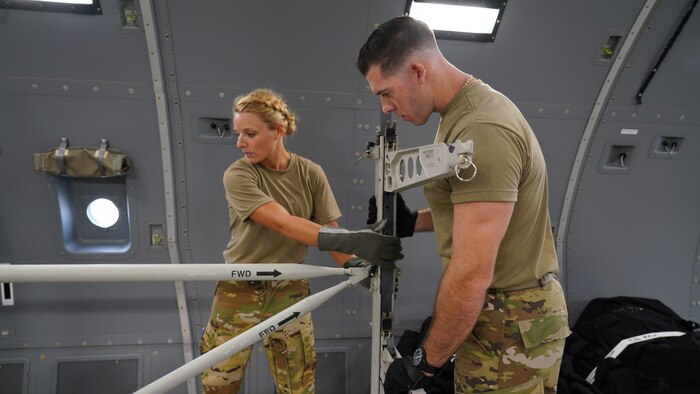
Patients, patients, and more patients
Capt. Elizabeth Beaty and 1st Lt. Zach Cates, 36th Aeromedical Evacuation Squadron flight nurses, set up the litter stantion sets for patient transport during training on the newest Air Force air refueling tanker, the KC-46A Pegasus, flown by the 77th Air Refueling Squadron from the 916th Air Refueling Wing, August 16-19, 2022. Aeromedical personnel are required to train on all airframes with patient care transport capability. They must learn the patient loading and unloading, the setup of the litter stantions, to knowing where medical equipment plug ins are located, as well as the emergency evacuation procedures from the aircraft while on the ground. (U.S. Air Force photo by Senior Master Sgt. Jessica Kendziorek)
1 of 11
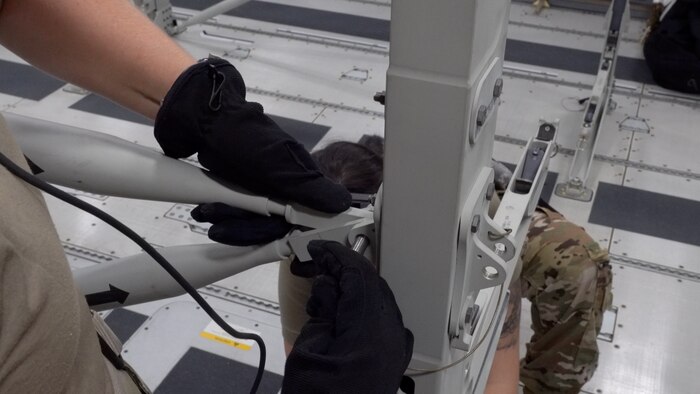
Patients, patients, and more patients
Members of the 36th Aeromedical Evacuation Squadron from the 403rd Wing set up the litter stantion sets for patient transport during their training on the newest Air Force air refueling tanker, the KC-46A Pegasus, flown by the 77th Air Refueling Squadron from the 916th Air Refueling Wing, August 16-19, 2022. Aeromedical personnel are required to train on all airframes with patient care transport capability. They must learn the patient loading and unloading, the setup of the litter stantions, to knowing where medical equipment plug ins are located, as well as the emergency evacuation procedures from the aircraft while on the ground. (U.S. Air Force photo by Senior Master Sgt. Jessica Kendziorek)
2 of 11
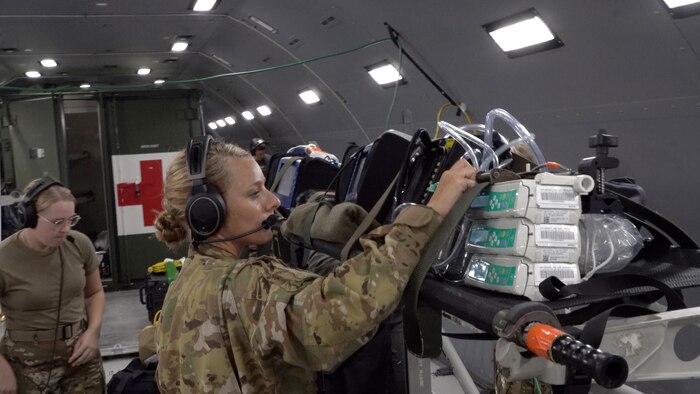
Patients, patients, and more patients
Capt. Elizabeth Beaty, 36th Aeromedical Evacuation Squadron flight nurse, checks on the supplies and ensures the precheck of the medical equipment is completed prior to take-off during their training on the newest Air Force air refueling tanker, the KC-46A Pegasus, flown by the 77th Air Refueling Squadron from the 916th Air Refueling Wing, August 16-19, 2022. Aeromedical personnel are required to train on all airframes with patient care transport capability. They must learn the patient loading and unloading, the setup of the litter stantions, to knowing where medical equipment plug ins are located, as well as the emergency evacuation procedures from the aircraft while on the ground. (U.S. Air Force photo by Senior Master Sgt. Jessica Kendziorek)
3 of 11
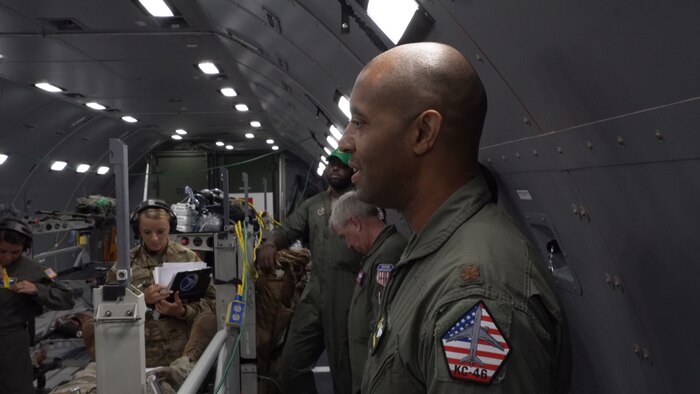
Patients, patients, and more patients
Maj. Tandon Mardis, 77th Air Refueling Squadron pilot and aircraft commander, conducts the aircraft crew brief before take-off with members of the 36th Aeromedical Evacuation Squadron from the 403rd Wing, who were training on the newest Air Force air refueling tanker, the KC-46A Pegasus, flown by the 77th ARS from the 916th Air Refueling Wing, August 16-19, 2022. Aeromedical personnel are required to train on all airframes with patient care transport capability. They must learn the patient loading and unloading, the setup of the litter stantions, to knowing where medical equipment plug ins are located, as well as the emergency evacuation procedures from the aircraft while on the ground. (U.S. Air Force photo by Senior Master Sgt. Jessica Kendziorek)
4 of 11

Patients, patients, and more patients
1st Lt. Cheryl Smith, 36th Aeromedical Evacuation Squadron nurse, and Senior Airman Joseph Bernal, 36th AES aeromedical evacuation technician, secure the litter of the 'patient' to the litter stantion of the KC-46A Pegasus, flown by the 77th Air Refueling Squadron from the 916th Air Refueling Wing, during their training on the newest Air Force air refueling tanker, August 16-19, 2022. Aeromedical personnel are required to train on all airframes with patient care transport capability. They must learn the patient loading and unloading, the setup of the litter stantions, to knowing where medical equipment plug ins are located, as well as the emergency evacuation procedures from the aircraft while on the ground. (U.S. Air Force photo by Senior Master Sgt. Jessica Kendziorek)
5 of 11
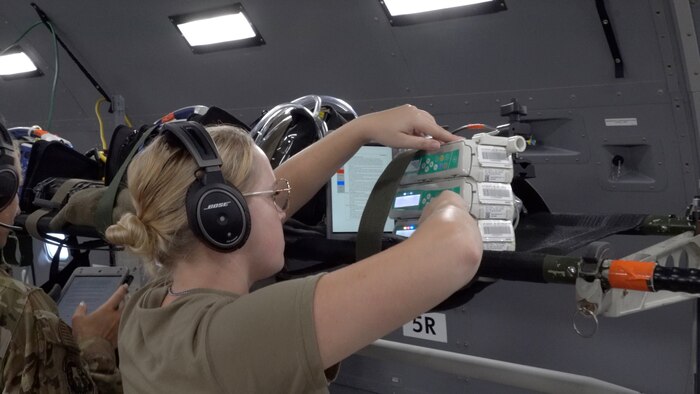
Patients, patients, and more patients
Staff Sgt. Madison Ross, 36th Aeromedical Evacuation Squadron aeromedical technician, conducts an operational precheck on the medical equipment prior to take-off during the training on the newest Air Force air refueling tanker, the KC-46A Pegasus, flown by the 77th Air Refueling Squadron from the 916th Air Refueling Wing, August 16-19, 2022. Aeromedical personnel are required to train on all airframes with patient care transport capability. They must learn the patient loading and unloading, the setup of the litter stantions, to knowing where medical equipment plug ins are located, as well as the emergency evacuation procedures from the aircraft while on the ground. (U.S. Air Force photo by Senior Master Sgt. Jessica Kendziorek)
6 of 11

Patients, patients, and more patients
Members of the 36th Aeromedical Evacuation Squadron from the 403rd Wing secure a 'patient' on a litter to the litter stantion sets during training on the newest Air Force air refueling tanker, the KC-46A Pegasus, flown by the 77th Air Refueling Squadron from the 916th Air Refueling Wing, August 16-19, 2022. Aeromedical personnel are required to train on all airframes with patient care transport capability. They must learn the patient loading and unloading, the setup of the litter stantions, to knowing where medical equipment plug ins are located, as well as the emergency evacuation procedures from the aircraft while on the ground. (U.S. Air Force photo by Senior Master Sgt. Jessica Kendziorek)
7 of 11

Patients, patients, and more patients
Staff Sgt. Anna Wicker, 36th Aeromedical Evacuation Squadron aeromedical technical, removes the blood pressure cuff from "patient" Staff Sgt. Malik Pitts, 916th Aircraft Maintenance Squadron avionics technician, after checking his vitals during training on the newest Air Force air refueling tanker, the KC-46A Pegasus, flown by the 77th Air Refueling Squadron from the 916th Air Refueling Wing, August 16-19, 2022. Aeromedical personnel are required to train on all airframes with patient care transport capability. They must learn the patient loading and unloading, the setup of the litter stantions, to knowing where medical equipment plug ins are located, as well as the emergency evacuation procedures from the aircraft while on the ground. (U.S. Air Force photo by Senior Master Sgt. Jessica Kendziorek)
8 of 11
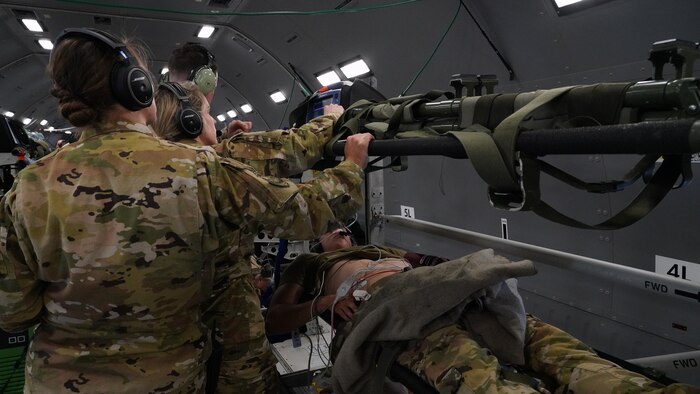
Patients, patients, and more patients
Nurses from the 36th Aeromedical Evacuation Squadron check the electrocardiogram readout of a 'patient' during flight, while training on the newest Air Force air refueling tanker, the KC-46A Pegasus, flown by the 77th Air Refueling Squadron from the 916th Air Refueling Wing, August 16-19, 2022. Aeromedical personnel are required to train on all airframes with patient care transport capability. They must learn the patient loading and unloading, the setup of the litter stantions, to knowing where medical equipment plug ins are located, as well as the emergency evacuation procedures from the aircraft while on the ground. (U.S. Air Force photo by Senior Master Sgt. Jessica Kendziorek)
9 of 11
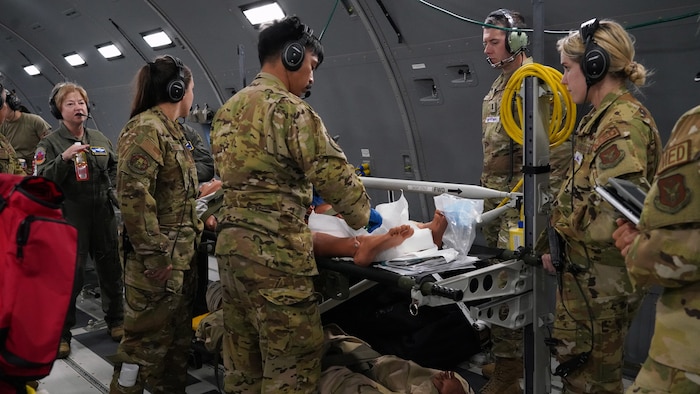
Patients, patients, and more patients
Medical technicians from the 36th Aeromedical Evacuation Squadron practice keeping a sterile field while performing a procedure during flight while training on the newest Air Force air refueling tanker, the KC-46A Pegasus, flown by the 77th Air Refueling Squadron from the 916th Air Refueling Wing, August 16-19, 2022. Aeromedical personnel are required to train on all airframes with patient care transport capability. They must learn the patient loading and unloading, the setup of the litter stantions, to knowing where medical equipment plug ins are located, as well as the emergency evacuation procedures from the aircraft while on the ground. (U.S. Air Force photo by Senior Master Sgt. Jessica Kendziorek)
10 of 11
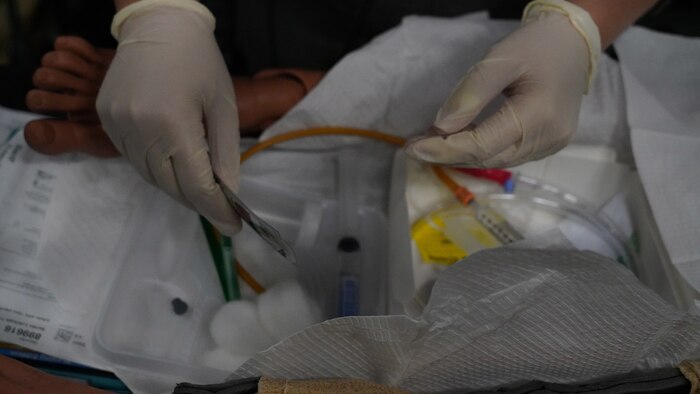
Patients, patients, and more patients
Medical technicians from the 36th Aeromedical Evacuation Squadron practice keeping a sterile field while performing a procedure during flight while training on the newest Air Force air refueling tanker, the KC-46A Pegasus, flown by the 77th Air Refueling Squadron from the 916th Air Refueling Wing, August 16-19, 2022. Aeromedical personnel are required to train on all airframes with patient care transport capability. They must learn the patient loading and unloading, the setup of the litter stantions, to knowing where medical equipment plug ins are located, as well as the emergency evacuation procedures from the aircraft while on the ground. (U.S. Air Force photo by Senior Master Sgt. Jessica Kendziorek)
11 of 11
“It was definitely a learning experience. I haven’t done anything with these litter stantion sets since school because we primarily fly on the C-130,” said Capt. Mallory Maxwell, 36th AES flight nurse and three-time medical crew director on her first training flights on the KC-46. “I think it went pretty smoothly and that we all did pretty well being flexible and getting used to a new aircraft.”
Staff Sgt. Dylan Callais, 36th AES, aeromedical evacuation technician and mission crew coordinator, agreed saying that the crew improved from a 21-minute set-up on day one to a 15-minute set-up by day three.
Callais was one of the people in charge and ran all of the simulations to make sure the crew received effective training throughout the flights using a mission packet that was created beforehand with a list of “patients” and their illnesses. His job was to look at the list and provide scenarios of “what if this happens” during flight.
Some of the “what ifs” included medical situations and to check the AE crews’ response to aircraft emergency simulations and make sure that they reacted correctly.
“We have to think outside of the box,” said Callais. “We don’t want them to just talk through the scenario, we want them to react, act out the situation, and also see how they would treat the patients.”
The goal of the training is to see what the medical technicians understand compared to the nurses on how the patients can change during flight, because while not only do they have to maintain the patients’ ongoing medical issues, but they have to be aware of flight stressors that can occur.
“In the Reserve, not all of our techs are in the medical field on the outside,” said Callais. “While some may work on fire trucks or ambulances, others work in coffee shops, restaurants and other places, so we have to look at our training and where the learning curve may be to improve and grow.”
Most of the flight nurses work in different areas of expertise, which is a benefit when it comes to providing care.
“I work in pediatrics, while some of the others work in the ICU (intensive care unit) or in the ER (emergency room),” said Maxwell. “This brings different sets of skills and experience to the aircraft, which is helpful when we are taking care of patients.”
When it came to being the medical crew director, Maxwell’s primary responsibility was to direct the crew, herself, the other flight nurse, the medical techs and coordinate the mission to make sure everything went smoothly, while taking care of patients in a safe manner.
“As a new flyer, I wasn’t feeling extremely confident in what I was doing, especially on a new aircraft,” said Maxwell, “But, after this training and doing more missions as the MCD, I am feeling better and more comfortable with giving directions.”
Being new didn’t only apply to the AES personnel because this aeromedical evacuation training mission flight was also a first for Maj. Tandon Mardis, 77th Air Refueling Squadron aircraft commander and pilot from Seymour Johnson Air Force Base, North Carolina.
 “This is my first AE mission in my Air Force career and my first on the KC-46,” said Mardis. “And even though this is a training mission for both the front and back end of the jet, this is one of the best missions of the Air Force while flying.”
“This is my first AE mission in my Air Force career and my first on the KC-46,” said Mardis. “And even though this is a training mission for both the front and back end of the jet, this is one of the best missions of the Air Force while flying.”
Mardis said that it proves to be one of the most rewarding missions and made him realize the effects of operating the aircraft safely.
“I think at the end of the day,” said Mardis. “Being able to move the patient safely, you feel like you got your job done today.”
While everyone agreed that the training went well, Bernal said he would like to see the emergency egress slide incorporated into the training.
“I think being able to use a training slide, and actually practice on how to deploy it would be helpful,” said Bernal. “That way we can practice getting our patients and ourselves down it safely, which would be better than having to use it the first time in an actual emergency situation.”
At the end of the off-station training session a lot was learned, from being more comfortable at giving direction, to better set-ups, to the different stressors of flight for the patients based on the aircraft, even to the aircrew learning more about the AE mission.
“It has been wonderful. I think AE is cut from a different cloth,” said Mardis. “To see how everybody works together, it is a mission that is different from others but is very gratifying.”